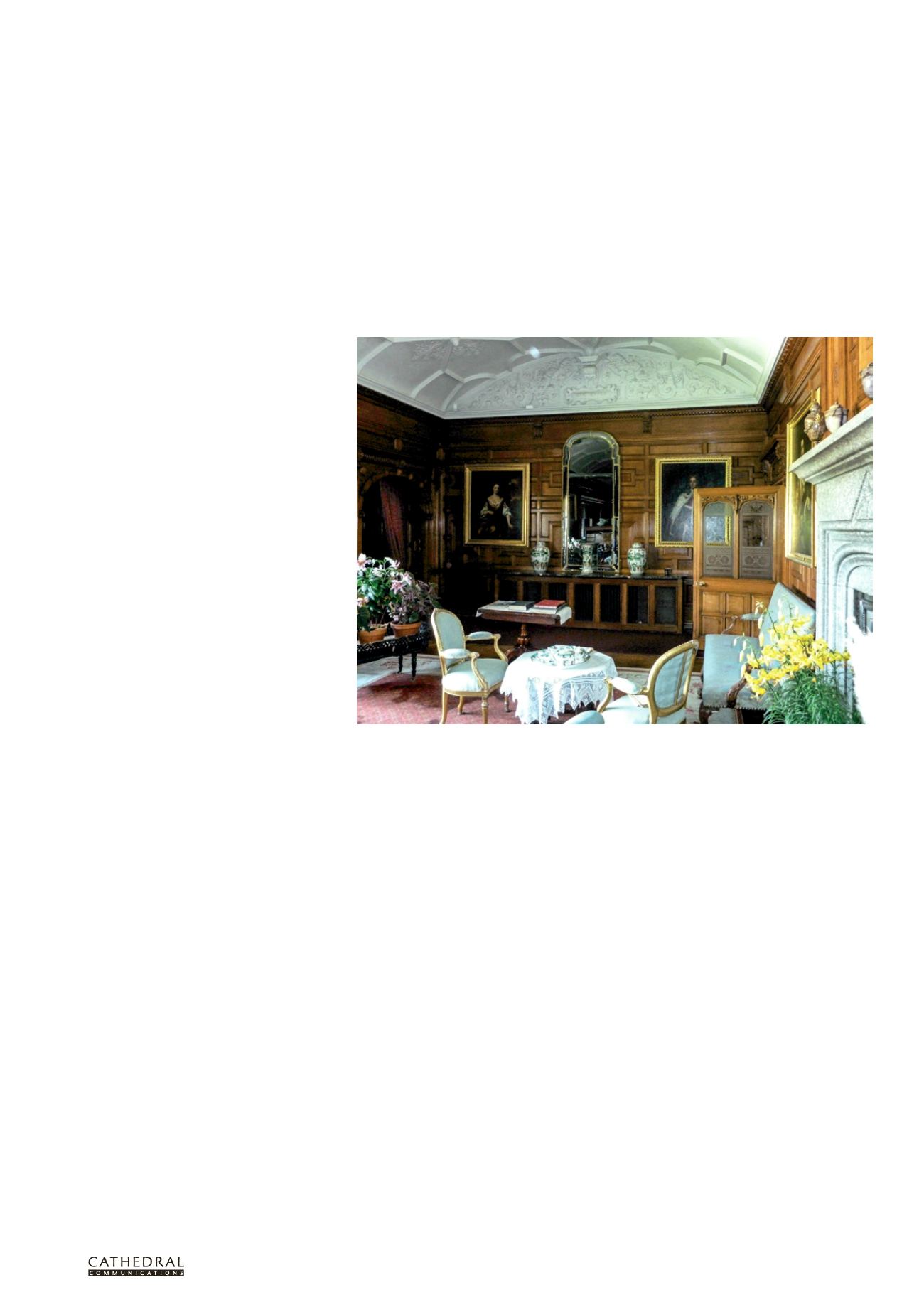
T W E N T Y F I R S T E D I T I O N
T H E B U I L D I N G C O N S E R VAT I O N D I R E C T O R Y 2 0 1 4
1 5 1
4.2
SERVICES & TREATMENT :
HEATING & LIGHTING SER VICES
FIRE CONTROL MEASURES
AT LANHYDROCK
PAUL HOLDEN
L
ANHYDROCK HOUSE
is a Grade I listed
mansion situated on the edge of Bodmin
Moor in Cornwall. Since 1621 it has
been home to successive generations of the
Robartes family. After a major fire in 1881 the
house underwent a four-year refurbishment
programme before becoming a family home
again. Serious attention was paid to fire risk in
the early 1990s when an advanced automatic
fire alarm system was installed alongside a
series of fire doors which extended physical
vertical compartmentation to the ground and
first floor service corridors and, in the process,
created two new protected staircases for
means of escape.
In 2005, 60 years after the National Trust
took ownership, the Regulatory Reform (Fire
Safety) Order was passed. In response the
National Trust commissioned a detailed risk
assessment from which a two-year phased
schedule of works was instigated to develop
the property’s passive and active fire safety
strategies. The project posed many challenges,
not least in effecting statutory change without
any visible impact on the building and its
outstanding interiors.
PASSIVE MEASURES
When planning a historic building’s passive
fire safety strategy, it is essential to first
evaluate the property’s historic layout and
construction to minimise damage to the fabric
and reduce overall costs. Like most buildings,
Lanhydrock benefits from natural lines of
compartmentation – a consequence of the
historic floor plan. Furthermore, the post-fire
refurbishment was specifically carried out
with fire safety in mind. The Victorian iron
fabricated structure significantly reduced
the amount of timber beneath floors and
throughout the roof voids, while 12”-thick
concrete ceilings then, as now, offer sound fire
resistance between floors. If they are carefully
monitored and maintained these historic
features will still provide 60 minutes fire
separation. However, if they are compromised,
the building’s ability to withstand fire spread
will be seriously undermined.
One such weakness was discovered
beneath the ground floor in the brick vaulted
tunnels (now a service duct) which connect
the boiler room with the historic interiors.
The risk assessment identified the high
potential for fire spread from the boiler
room into the tunnels and thence vertically
and horizontally into the mansion. One
Lanhydrock’s spectacular Drawing Room: a pragmatic solution in the form of a simple risk assessment was
implemented to prevent damage to this 19th-century highly carved door with etched glass
option was to install fire shutters or curtains
throughout the tunnel, corresponding
with vertical compartment lines above.
However, this intervention would have
restricted easy access through the tunnels
and compromised an important bat roost.
A more practical solution was to seal the
many pipe-work and cabling breaches
in the roof and sides of the tunnels with
proprietary sealing systems and to add a fire
door and shutter at each entry point, thereby
creating a single horizontal compartment.
Maintaining the integrity of masonry
walls is vital in order to inhibit the spread of
fire, heat and smoke. However, Lanhydrock’s
fire risk assessment identified the need to
examine, repair and upgrade all elements
of each vertical compartment. For example,
historic panelled doors were upgraded with
leaf edge perimeter seals and intumescent
hinge papers and varnishes. To reduce
the risk of unseen fire spread through the
door frame itself, all cavities were sealed
behind architraves and beneath floors with
masonry, intumescent sponges and sealants
in order to achieve a fire-resistance duration
comparable with the walls. Before work was
carried out careful thought was given to the
disturbance of the historic fabric and how
modern interventions can compromise the
operation of the property. One example that
had to be overcome was the potential risk
in blocking or hindering natural ventilation
systems beneath floors that would in turn
compromise the ability to maintain a constant
relative humidity throughout the property
for collections care. By sealing necessary gaps
beneath floors and installing intumescent air-
vents, air flow was maintained until activated
by heat. (Heat causes the intumescent material
in the vent to expand forcefully, blocking the
potential fire path.)
Partly because the use of the mansion had
changed since the 1990s, the risk assessment
identified the need to create three new
vertical compartments, one to separate the
internationally important 17th-century gallery
(and the shop area below) from the rest of the
house, and the other two to create further
protected staircases for means of escape. To
facilitate this upgrade, three new bespoke
fire doors, based on Victorian patterns,
were introduced into the historic interior
and two historic lift shafts that breached all
levels of the property were treated as distinct
compartments and upgraded to suit.


